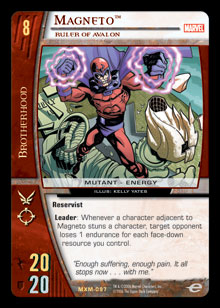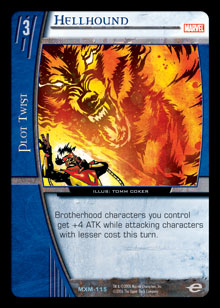
Bringing back the Brotherhood presented the R&D group with its biggest challenge in terms of character composition, design, and development. The Brotherhood team has had a strong tournament presence from the beginning, and multiple different Brotherhood builds have been ranked among the tier 1 decks throughout the game’s history. Step one to bringing back the Brotherhood was determining which characters to include in the new version of the team. We discussed repeating the Marvel Origins model of showcasing a sampling of characters from each of the Brotherhood incarnations. The idea would be to include new versions of the biggest named characters at different cost points while also introducing a new collection of yet-to-be released supporting characters.
We also looked at the more recent incarnations of the New Brotherhood, as well as other groups started by members of the classic Brotherhood, including Freedom Force and the Acolytes. To flesh out a full team in an expansion, we look for a presentation of roughly 25 to 30 characters. Reviewing each of the potential rosters, it looked like Magneto’s Acolytes could support a full team by themselves.
The next consideration was to evaluate if we wanted to make the Acolytes their own team. It would have solved a number of developmental concerns we had. After talking about this direction, we felt that making an Acolytes team wasn’t quite what we wanted to do. Bringing back the X-Men without the Brotherhood in Silver Age didn’t seem optimal, and while their character roster was plentiful, the Acolyte team hadn’t been featured in the comics for nearly as long or as prominently as the classic Brotherhood.
 Another problem with using just the Acolytes was that the only iconic Brotherhood member was Magneto himself—no Mystique, no Blob, no Sabretooth, no Pyro. On the X-Men side, we knew that we wanted to bring back a number of more popular characters, so it would have been a little unbalanced not to bring back a matching number of the Brotherhood characters from the Origins set. The Freedom Force team provided those characters, but their roster wasn’t large enough to fill out an entire team. They were missing Magneto, and they were potentially even less well-known than the Acolytes.
Another problem with using just the Acolytes was that the only iconic Brotherhood member was Magneto himself—no Mystique, no Blob, no Sabretooth, no Pyro. On the X-Men side, we knew that we wanted to bring back a number of more popular characters, so it would have been a little unbalanced not to bring back a matching number of the Brotherhood characters from the Origins set. The Freedom Force team provided those characters, but their roster wasn’t large enough to fill out an entire team. They were missing Magneto, and they were potentially even less well-known than the Acolytes.
The solution? Combine the two groups and re-use the sub-team version mechanic that appeared on the Wrecking Crew characters from the Avengers set. This allowed us to bring back the Brotherhood team and re-feature all of the Origins characters we wanted to see again, while letting the Acolytes and Freedom Force characters have their own feel and card-specific effects by referencing their versions. We also threw in a couple of big names that were not in either group (like Sabretooth) to round out the team.
Since Freedom Force had the largest number of classic members, I determined that they should most directly speak to what the Brotherhood was known for in Origins. Rush, fast beats, and aggro were all terms used to describe the play pattern of the original group. The team wants to hit fast, hit hard, and take out its opponents before they get the chance to play any late game tricks.
Looking back at the teams from the Avengers set, I noticed that the design direction I had taken for the peace-promoting Project Utopia members of the Squadron Supreme negated all breakthrough in favor of board control effects. So, if peace wanted to avoid breakthrough, then destruction would want to maximize it. The end result: Freedom Force characters would reward their controllers if they reached a certain level of breakthrough when they attacked.
What we couldn’t immediately agree on was what this amount of breakthrough should be. There were two strong directions evaluated. One potential path had a variable breakthrough amount, with each character paired with a breakthrough trigger commensurate to the effect it generated. This direction allowed a lot of design freedom and could work with the natural flow of the game, which had breakthrough levels rising as the turns progressed. The other model had all characters using the same breakthrough threshold value. The benefits included a clearly defined breakthrough goal for all characters. Plus, the ability to generate supplemental breakthrough effects on other cards at an established level would be useful to every character on the team.
This was a hard decision for me to make, as I saw the benefits that could be gained from both directions, and each side had strong advocates as to why it was the better path. What finally tipped it for me was the ability for the cards, as a mechanical theme, to cleanly show players a recognizable end goal, which turned out to be doing 3 or more breakthrough from an attack. How we picked 3 as this number is a story for another article.
This takes us to the design direction for the Acolyte characters. Format integration is a frequent topic of conversation around the Vs. R&D table. Since the creation of the Modern Age formats, we’ve been looking for ways for sets that appear together within a format to have a certain level of linked mechanical integration. From early indications, the Avengers reservist mechanic was looking like it had the level of traction from players that would warrant revisiting it in the X-Men set.
The Acolytes were a natural fit for the reservist theme, since they’re a replacement Brotherhood of sorts for Magneto in the comics. The next step was to design how the reservist play pattern for the Acolytes would be new and unique. Avengers reservist decks were looking to maintain a threshold number of reservist characters in their resource row, and Squadron zero hand decks were using reservists to get their hands down to zero cards.
Again, I went back to the basics and examined what it meant to be playing the Brotherhood in the Origins set. The old Brotherhood had been about pouring it on early and consistently each turn until it achieved victory. It wasn’t about holding back until the right moment to strike. They were vicious, lightning fast, and unrelenting. So, if Avengers reservists were all about building up, Brotherhood reservists wanted to cycle through resource row reservists as quickly as possible via replacement effects to dig into either a new reservist character or a useful plot twist.
 The last part of the process was to create plot twists, equipment, and locations to support the new characters. These seemed to quickly fall into place. Since both sub-teams supported aggro beats, it was easy to give the team support effects that would be familiar to Origins players. All of the old bases were covered—from cards like Hellhound that rewarded beating on the little guy, to Shake, Rattle, and Roll, which continued the Brotherhood legacy of location hate.
The last part of the process was to create plot twists, equipment, and locations to support the new characters. These seemed to quickly fall into place. Since both sub-teams supported aggro beats, it was easy to give the team support effects that would be familiar to Origins players. All of the old bases were covered—from cards like Hellhound that rewarded beating on the little guy, to Shake, Rattle, and Roll, which continued the Brotherhood legacy of location hate.
The only old direction that we chose to avoid somewhat were additional direct endurance loss effects. As one of the defining identities of the new Energy trait, we decided that if the Brotherhood wanted to burn out their opponents, they’d need to incorporate a number of the new Energy trait plot twists into their decks.
And that is the design story of the Big Bad Brotherhood in this set. Who knows what they’ll look like the next time we bring them back? But you can bet that whatever we do, the Brotherhood of Evil Mutants will be out for blood.